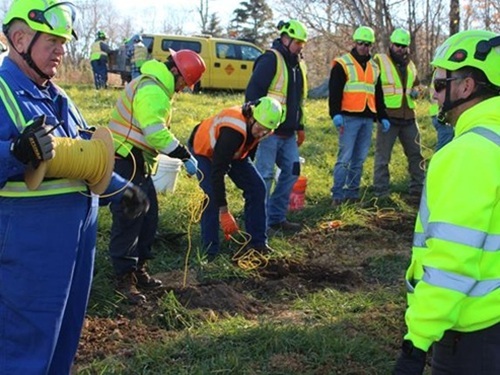ITR Concession Company LLC – manager of the Indiana Toll Road – and eX² Technology, LLC, recently completed a two-year $34 million project to install a fiber optic communications system as part of ITRCC’s Intelligent Transportation System expansion project that is significantly boosting motorist safety along the 157-mile tolled highway.
[Above photo by ITRCC]
The project installed conduit and fiber optic cable – commonly referred to as “broadband” – to complete ITRCC’s ITS network spanning Northern Indiana from the Illinois to the Ohio state lines.

Numerous ITS devices deployed along the Toll Road due to this expanded network are also providing dramatic safety improvements for the millions traveling the Indiana Toll Road annually. In 2020 alone, ITRCC said that this expanded ITS network helped reduce secondary crashes by 79 percent while providing advanced information to travelers regarding upcoming roadway conditions.
“The benefits of the fiber communications network extend far beyond safety,” explained Nic Barr, CEO of ITRCC, in a statement. “The Toll Road corridor connects to more than 124 million people and provides a wealth of opportunity to foster, support and propel local communities across Northern Indiana.”
Additionally, eX² Technology is in the process of designing, deploying, and integrating a truck parking information management system with an estimated November 2021 completion date. The truck parking system will connect and monitor a dozen truck-parking sites and dynamic message signs to provide truckers with real-time information on available truck parking spaces across the Toll Road corridor.

A state-level infrastructure report issued in 2019 reflects in detail a growing national trend that links the ability to expand broadband access to leveraging assets such as highway rights-of-way – especially for rural residents.
InnovateOhio, in partnership with the Ohio Department of Transportation, issued a 16-page broadband access report on September 24 – a report commissioned at the behest of Ohio Governor Mike DeWine (R) in June – to provide a strategic plan for “improving and expanding broadband” across the state.
The key finding of that report is that the rights-of-way along state-owned interstate highways “hold considerable value” that can be “leveraged in order to expand broadband.” However, the report cautioned that there is no “silver bullet,” noting that a variety of strategies are needed to make sure every Ohioan has access to high-speed internet.

In August 2020, the Federal Highway Administration proposed a new rule to improve coordination in the use of highway rights-of-way to support the installation of broadband technologies.
FHWA pointed out that its proposed rule would help improve coordination with construction projects and ensure that the digging required for utility lines also support installation of broadband infrastructure, decreasing repeat excavation and minimizing disruption to the traveling public.
State departments of transportation are already working to find ways to help expand broadband access to rural areas.
In coordination with the Arizona Commerce Authority, the Arizona Department of Transportation began “exploring partnerships” in July 2020 to create more affordable opportunities for wired and wireless broadband connectivity in rural communities.
 States
States
NCDOT Staff Participate in ‘Explosive’ Technical Training
December 19, 2025 States
States

